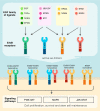Source and Impact of the EGF Family of Ligands on Intestinal Stem Cells
- PMID: 34350179
- PMCID: PMC8327171
- DOI: 10.3389/fcell.2021.685665
Source and Impact of the EGF Family of Ligands on Intestinal Stem Cells
Abstract
Epidermal Growth Factor (EGF) has long been known for its role in promoting proliferation of intestinal epithelial cells. EGF is produced by epithelial niche cells at the base of crypts in vivo and is routinely added to the culture medium to support the growth of intestinal organoids ex vivo. The recent identification of diverse stromal cell populations that reside underneath intestinal crypts has enabled the characterization of key growth factor cues supplied by these cells. The nature of these signals and how they are delivered to drive intestinal epithelial development, daily homeostasis and tissue regeneration following injury are being investigated. It is clear that aside from EGF, other ligands of the family, including Neuregulin 1 (NRG1), have distinct roles in supporting the function of intestinal stem cells through the ErbB pathway.
Keywords: Epidermal Growth Factor; ErbB; intestinal stem cells; neuregulin 1; niche; organoids; signaling; tissue regeneration.
Copyright © 2021 Abud, Chan and Jardé.
Conflict of interest statement
The authors declare that the research was conducted in the absence of any commercial or financial relationships that could be construed as a potential conflict of interest.
Figures


References
Publication types
LinkOut - more resources
Full Text Sources
Other Literature Sources
Research Materials
Miscellaneous

